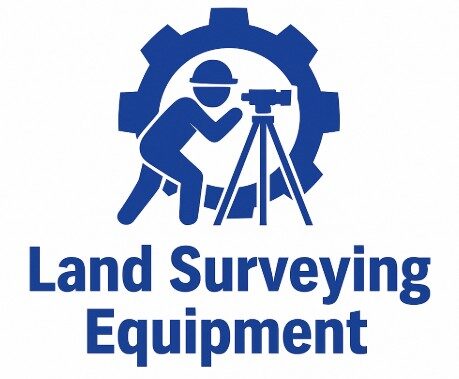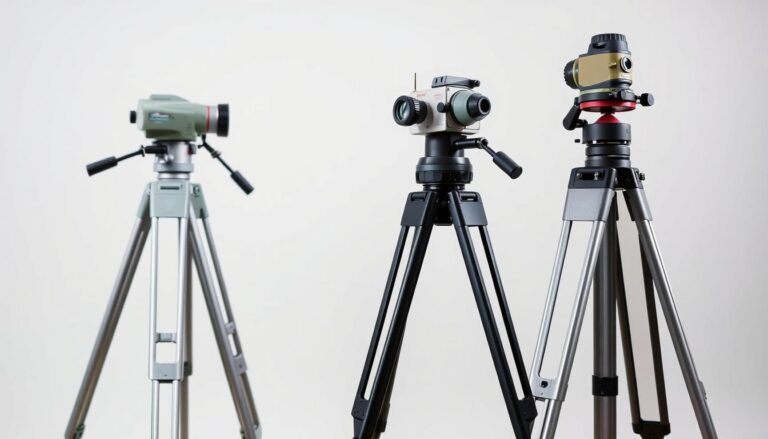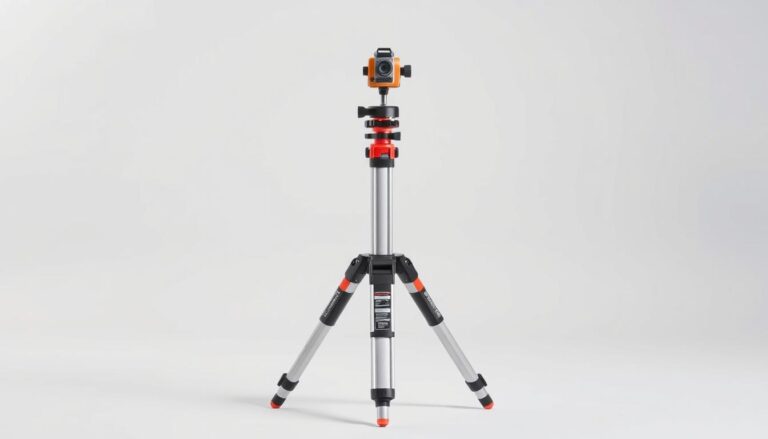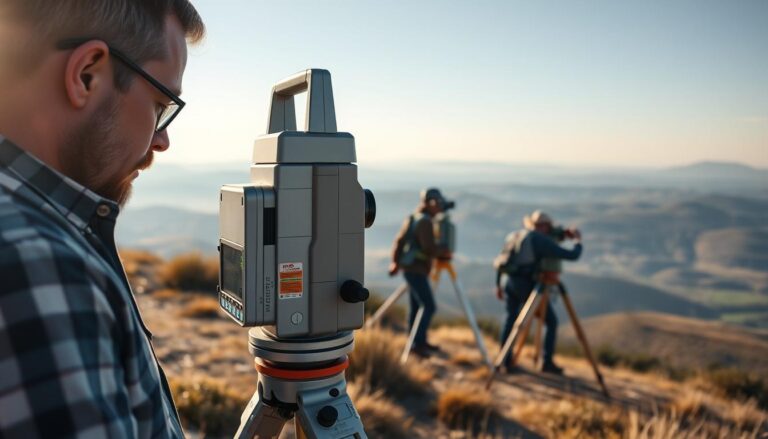Rolling Measuring Wheels: A Comprehensive Guide
Measuring distances accurately is key in many jobs, like surveying, construction, and landscaping. For ages, people have used a simple yet effective tool: the distance measuring wheel.
The measuring wheel, also known as an odometer, surveyor’s wheel, or trundle wheel, has a long history. It started in the 1600s as a way to measure long distances. Now, it’s a vital tool in many fields.
Top brands like Rolatape and Keson make high-quality measuring wheels. In this guide, we’ll cover the basics of measuring wheels, their history, and what to look for when choosing one.
Key Takeaways
- Understanding the history and evolution of measuring wheels
- Knowing the different types of measuring wheels available
- Identifying key features to look for in a measuring wheel
- Comparing products from top manufacturers like Rolatape and Keson
- Choosing the right measuring wheel for your specific needs
What Are Rolling Measuring Wheels?
The rolling measuring wheel is a key tool in many fields. It makes measuring lengths and perimeters easy. Measuring wheels are popular because they are simple and work well.
Older measuring wheels looked a lot like today’s models. The main difference is new parts that make them better and safer.
Basic Principles and Functionality
A rolling measuring wheel works by rolling on a surface. It has a handle and records the distance it travels. This is done with a counter, either mechanical or digital.
Modern wheels often have digital displays. These displays show exact measurements and can change units.
Types of Measuring Wheels Available
There are many types of measuring wheels, each for different needs. The main difference is between mechanical and digital measuring wheels. Mechanical wheels are tough and battery-free, while digital ones are precise and easy to use.
Top brands like Rolatape and Keson are well-known. Rolatape makes high-quality wheels for professionals. Keson has a variety for different uses.
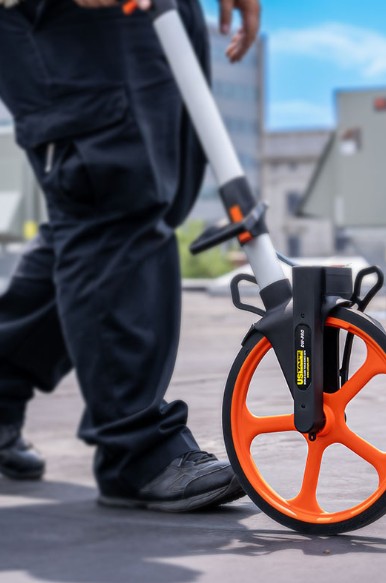
Rolling Measuring Wheels Explained: How They Work
To understand the value of rolling measuring wheels, we need to look at how they work. These tools are made to measure distances accurately. Their design and parts play a big role in this.
Using a measuring wheel is simple. First, place it on a starting point and reset the counter to zero. Then, walk until you reach your end point. The wheel’s size is set to turn into a distance, shown on the counter.
Mechanical Components and Design
A measuring wheel has a strong wheel, a handle, and a counter. The wheel is built to last on different surfaces. The counter shows how many times the wheel has turned, turning it into a distance.
Key design factors are the wheel’s size, the materials, and the counter type. These all help make the measuring wheel accurate and easy to use.
Digital vs. Analog Measuring Wheels
Measuring wheels are either digital or analog. Analog measuring wheels have a mechanical counter for simple, reliable readings. Digital measuring wheels show exact numbers on an LCD screen and may have extra features.
Choosing between digital and analog depends on what you need. Digital wheels are great for those who want advanced features and precision. Analog wheels are better for those who like simplicity.
7 Key Benefits of Using Rolling Measuring Wheels
Rolling measuring wheels offer many advantages, making them a key tool in many fields. They are great for getting rough measurements of big areas or spaces.
Here are the main benefits of using rolling measuring wheels:
1. Superior Accuracy for Professional Measurements
Measuring wheels give accurate measurements for experts, especially for big areas. They are made to cut down on mistakes and give dependable results.
2. Efficiency in Large Area Measurements
Measuring wheels are great for measuring big areas quickly. They are perfect for jobs like surveying, building, and gardening.
3. Versatility Across Different Terrains
Measuring wheels are versatile tools that work on many surfaces, even rough ones. This makes them good for lots of tasks.
4. Time-Saving Advantages
Using a measuring wheel can save a lot of time on measurement tasks. This is great for people who need to work fast and efficiently.
5. Ease of Use Compared to Other Methods
Measuring wheels are easy to use, more so than other ways to measure. They need little training and can be used by one person.
6. Portability and Storage Benefits
Most measuring wheels are easy to carry and store because they are small and light. This is a big plus for people who have to move their tools around.
7. Cost-Effectiveness for Professionals
Measuring wheels are a cost-effective choice for those who need precise measurements. They are often cheaper than other tools and offer good value over time.
To show the benefits of measuring wheels, let’s compare them:
| Measurement Tool | Accuracy | Efficiency | Cost |
|---|---|---|---|
| Measuring Wheel | High | High | Low-Moderate |
| Tape Measure | High | Low | Low |
| GPS Device | Moderate | High | High |
As “Measuring wheels are an essential tool for any professional or individual requiring accurate and efficient measurements.”
5 Top Industries That Use Measuring Wheels
Measuring wheels are key in many professional fields. They help with accuracy and efficiency. These tools are reliable and versatile in different tasks.
1. Construction and Surveying Applications
In construction and surveying, measuring wheels measure distances and layouts. They help verify building site dimensions. They’re great for quick area assessments.
2. Landscaping and Agriculture Uses
Landscapers and farmers use measuring wheels to measure plots and fields. This helps in planning and executing projects well.
3. Sports Field Management
Sports field managers use measuring wheels to mark and maintain fields. Accurate measurements are key for fair play.
4. Road and Highway Maintenance
Measuring wheels are vital for road maintenance crews. They measure distances, mark repair areas, and check road conditions.
5. Real Estate and Property Assessment
Real estate and property assessors use measuring wheels. They determine property boundaries and measure land areas. This ensures accurate property dimensions.
| Industry | Primary Use | Benefits |
|---|---|---|
| Construction and Surveying | Measuring distances and layouts | Efficiency, accuracy |
| Landscaping and Agriculture | Measuring plots and fields | Project planning, execution |
| Sports Field Management | Marking and maintaining fields | Regulatory compliance |
| Road and Highway Maintenance | Measuring distances and road conditions | Maintenance planning |
| Real Estate and Property Assessment | Determining property boundaries | Accurate property assessment |
Rolatape: Brand Overview and Top Models
Rolatape has a long history in the measuring wheel industry. It’s known for quality and innovation. This has made it a top choice for professionals in many fields.
History and Reputation in the Industry
Rolatape is a trusted name in measuring wheels. It’s known for its high-quality products. The brand focuses on precision and durability, making it a favorite among professionals.
Rolatape’s measuring wheels can handle tough use. They ensure accurate measurements in different settings.
Rolatape Professional Series Models
The Rolatape Professional Series is built for heavy-duty use. It has advanced features for precise measurements. These models are perfect for professionals who need accuracy and reliability.
Key Features and Specifications
The Professional Series models have high-precision counters and durable wheels. They also have ergonomic handles. These features help professionals work efficiently and accurately, even in tough environments.
- High-precision counters for accurate measurements
- Durable wheels designed for heavy-duty use
- Ergonomic handles for comfortable operation
Pros and Cons
The Professional Series has many benefits, like high accuracy and durability. But, they might be pricier than other options.
Pros:
- High accuracy and reliability
- Durable construction
- Ergonomic design
Cons:
- Higher price point
Rolatape Economy Models
Rolatape’s Economy Models are for those who need reliable measurements without the extra features. They’re great for occasional use or for those watching their budget.
Key Features and Specifications
The Economy Models provide reliable measurements with simpler features. They’re designed to be easy to use and maintain.
- Simplified counter display
- Durable wheel construction
- Easy-to-use design
Pros and Cons
The Economy Models are more affordable and still reliable. But, they might not have all the advanced features of the Professional Series.
Pros:
- Affordable price
- Reliable measurements
Cons:
- Limited features
Keson: Brand Overview and Top Models
Keson is a top name in measuring wheels, known for quality and reliability. They serve many industries like construction, surveying, and landscaping.
People trust Keson for their accurate and durable measuring wheels. They are easy to use, too.
History and Reputation in the Industry
Keson has been around for decades, making high-quality measuring tools. They focus on innovation and making customers happy.
Keson’s key strengths include:
- High-precision measuring wheels
- Innovative design and technology
- Durable products built to last
- Excellent customer service
Keson Professional Series Models
The Professional Series is for tough jobs. It has advanced features and is very accurate.
Key Features and Specifications
The Professional Series comes with:
| Model | Wheel Diameter | Counter Type | Accuracy |
|---|---|---|---|
| PR-360 | 12 inches | Digital | ±0.02% |
| MF-10 | 10 inches | Mechanical | ±0.05% |
Pros and Cons
Pros:
- High accuracy and reliability
- Durable construction
- Advanced features like digital counters
Cons:
- Generally more expensive than economy models
- Some users may find the digital counter complex
Keson Economy Models
The Economy Models are for casual or occasional use. They are affordable without losing quality.
Key Features and Specifications
The Economy Models have:
| Model | Wheel Diameter | Counter Type | Accuracy |
|---|---|---|---|
| MF-5 | 5 inches | Mechanical | ±0.1% |
| PR-100 | 8 inches | Digital | ±0.05% |
Pros and Cons
Pros:
- Affordable pricing
- Easy to use
- Suitable for small projects
Cons:
- Less accurate than professional models
- May not be as durable
Rolatape vs. Keson: Head-to-Head Comparison
Two brands, Rolatape and Keson, are leaders in measuring wheels. They are known for their quality and accuracy. This comparison will help you decide which one is best for you.
Build Quality and Durability
Both Rolatape and Keson measuring wheels are built to last. Rolatape wheels are known for their tough design, perfect for tough jobs. Keson offers durable models for heavy use. Your choice depends on your job needs.
Accuracy and Precision
Measuring wheels need to be accurate. Keson measuring wheels are known for their precision, great for detailed work. Rolatape also provides accurate measurements, with some models having advanced counters. The difference in accuracy is small but important for some jobs.
Price Points and Value
Price matters when choosing a measuring wheel. Rolatape is a bit pricier than Keson for similar models. But both offer great value for their quality. Your choice depends on what features you need and your budget.
Warranty and Customer Support
| Brand | Warranty Period | Customer Support |
|---|---|---|
| Rolatape | Lifetime warranty on some models | Excellent customer service |
| Keson | Limited lifetime warranty | Responsive customer support |
In conclusion, both Rolatape and Keson make high-quality measuring wheels. Choose based on your needs, like durability, accuracy, price, and support.
3 Other Notable Measuring Wheel Brands
While Rolatape and Keson are well-known, brands like Calculated Industries, Stanley, and AdirPro also make reliable measuring wheels.
These brands have their own strengths. They meet different needs and preferences.
1. Calculated Industries Models
Calculated Industries is famous for its precision and new designs. Their measuring wheels are for professionals who need exact measurements. They offer various models with digital displays and strong builds.
2. Stanley Measuring Wheels
Stanley is a big name in tools, and their measuring wheels show their quality. They are durable and easy to use, making them a favorite among pros.
3. AdirPro Professional Wheels
AdirPro makes professional-grade measuring wheels for tough jobs. Their wheels are known for being accurate and built to last, fitting many uses.
| Brand | Key Features | Notable Models |
|---|---|---|
| Calculated Industries | Precision, digital displays | Various professional series models |
| Stanley | Durability, ease of use | Multiple models for different applications |
| AdirPro | Professional grade, robust build | High-end models for heavy-duty use |
How to Choose the Right Measuring Wheel: 6 Factors to Consider
Choosing the right measuring wheel is key for professionals who need exact measurements. Several factors should be thought about to make sure it fits your needs and preferences.
1. Wheel Size and Diameter Impact
The size and diameter of the measuring wheel matter a lot. A bigger wheel is better for long distances. A smaller wheel is great for tight spots or short distances.
2. Handle Design and Ergonomics
The handle’s design and ergonomics are very important. A well-made handle makes using the wheel easier and less tiring, especially for long periods.
3. Counter Display Types and Readability
The counter display is key, and how easy it is to read matters a lot. Digital displays are very precise. Analog displays are more traditional and easy to understand.
4. Durability and Construction Materials
The durability of a measuring wheel depends on its materials. High-quality materials like stainless steel or strong plastics can handle tough environments and heavy use.
5. Folding vs. Fixed Design
The design of the measuring wheel, whether it folds or is fixed, affects how easy it is to carry and store. Folding models are more compact and easy to store. Fixed designs are often more sturdy.
6. Budget Considerations
Money is a big factor when picking a measuring wheel. It’s important to find a balance between cost and quality to get the best value.
| Factor | Considerations | Impact |
|---|---|---|
| Wheel Size | Diameter, circumference | Measurement accuracy, ease of use |
| Handle Design | Ergonomics, material | User comfort, fatigue reduction |
| Counter Display | Digital vs. analog, readability | Measurement precision, user experience |
| Durability | Materials, build quality | Lifespan, performance in harsh environments |
| Design Type | Folding vs. fixed | Portability, storage convenience |
| Budget | Cost vs. features | Value for investment, cost-effectiveness |
Measuring Wheel Accuracy: Factors and Limitations
It’s important to know what affects measuring wheel accuracy. These tools are used in many industries. But, their accuracy can change based on several factors.
Key Factors Affecting Accuracy
Surface Type Effects on Accuracy
The surface a measuring wheel is used on greatly affects its accuracy. For example, smooth surfaces like pavement or concrete give more accurate readings. But, rough or uneven surfaces like grass or gravel can cause the wheel to bounce or wobble. This leads to wrong readings.
Also, soft surfaces like sand or mud can make the wheel sink. This affects the measurement too.
- Smooth surfaces: pavement, concrete
- Rough surfaces: grass, gravel
- Soft surfaces: sand, mud
Calibration and Maintenance for Optimal Accuracy
Regular calibration and maintenance are key for accurate measuring wheels. Calibration checks the wheel’s measurement against a known standard. Maintenance includes cleaning and checking for wear and tear.
Proper storage and handling also help keep the wheel accurate.
“Regular calibration is key to ensuring the accuracy of measuring wheels.”
By understanding what affects measuring wheel accuracy and maintaining them, professionals can get reliable measurements. This is important in many applications.
How to Use a Measuring Wheel: 5-Step Guide
Getting accurate measurements with a measuring wheel starts with setting it up right. You need to know how to use it and its features. A systematic approach is key to getting reliable results.
1. Proper Setup and Preparation
Make sure the measuring wheel is in good shape and calibrated. Reset the counter to zero and clean the wheel. Proper setup is crucial for accurate measurements.
2. Correct Walking Technique
Walk steadily and consistently with the measuring wheel. Don’t make jerky movements or drag the wheel. A smooth, steady pace ensures reliable measurements.
3. Reading and Resetting the Counter
Learn how to read the counter on your measuring wheel. Most show both metric and imperial units. Reset the counter to zero after each use.
4. Measuring Curved and Irregular Paths
For curved or irregular paths, break the measurement into segments if needed. This keeps your measurement accurate, even on complex routes.
5. Common Mistakes to Avoid
Don’t make mistakes like wrong counter readings or not resetting the counter. Also, avoid using the wrong unit of measurement. Knowing these common errors can help improve your measurements.
By following these steps and watching out for common mistakes, you can get accurate and reliable measurements with your measuring wheel.
Maintenance and Care Tips for Longevity
Keeping your measuring wheel in top shape is key for accurate measurements. To do this, follow some easy maintenance and care tips.
Regular cleaning and proper storage are crucial for your measuring wheel’s life. Here are some best practices to follow:
Cleaning and Storage Best Practices
- Clean the wheel regularly with a soft cloth to remove dirt and debris.
- Store the measuring wheel in a dry place, away from direct sunlight.
- Keep the measuring wheel protected from extreme temperatures.
By following these simple steps, you can keep your measuring wheel in great condition.
Troubleshooting Common Issues
Even with good care, problems can still happen. Here are some common issues and their solutions:
- Inaccurate measurements: Check for worn-out tires or loose calibration.
- Counter not resetting: Ensure the counter is clean and free from debris.
- Wheel not rotating smoothly: Lubricate the wheel’s axle or check for blockages.
By fixing these common problems, you can keep your measuring wheel working well.
Measuring Wheel Accessories Worth Considering
Think about getting accessories to make your measuring wheel better. They can make it last longer and work better.
Measuring wheels are used in many fields. The right accessories can make them work better and last longer.
Protective Cases and Carrying Options
Protective cases and carrying options are key for measuring wheels. They keep your device safe and easy to carry.
A good case protects your measuring wheel from harm. It keeps it safe from dust and bad weather too.
There are many carrying options. You can choose from hard-shell cases, soft pouches, and clip-on holsters. Each one offers different levels of protection and ease.
Replacement Parts and Performance Upgrades
Replacing parts and upgrading your measuring wheel can make it better. It can make it more accurate and work better.
Some common parts to replace include wear-resistant tires, precision bearings, and digital counter displays.
| Accessory | Description | Benefits |
|---|---|---|
| Protective Case | Hard-shell or soft case for safe storage | Prevents damage, dust protection |
| Replacement Tires | Wear-resistant tires for improved traction | Enhanced accuracy, longer lifespan |
| Digital Counter | High-precision digital display for accurate measurements | Easy readability, precise measurements |
Getting the right accessories can make your measuring wheel better. It ensures you get accurate and reliable measurements.
Conclusion
Rolling measuring wheels are useful in many fields like construction, landscaping, and sports field management. This guide has shown how these tools help measure large areas with great accuracy and ease. They make work more efficient.
Knowing about rolling measuring wheels is key for professionals. It helps them choose the right tool for their needs. Whether it’s a Rolatape or a Keson, the right choice depends on your specific needs.
When picking a measuring wheel, think about the wheel size, handle, and display. These details matter a lot. Taking good care of your measuring wheel and using the right accessories can make it last longer and work better.
This guide helps professionals find the perfect measuring wheel for their projects. It ensures they get accurate and efficient measurements. Now, they can confidently choose the right tool for their work.
FAQ
What is a rolling measuring wheel?
A rolling measuring wheel is a tool for measuring distances. It’s used in construction, landscaping, and surveying. It has a wheel attached to a handle that rolls on the ground to measure distance.
How accurate are measuring wheels?
Measuring wheels can be very accurate. Some models are off by just 1/8 inch per 100 feet. But, accuracy can change based on the surface, wheel wear, and how you use it.
What are the different types of measuring wheels available?
There are mechanical and electronic measuring wheels. Mechanical ones use a counter mechanism. Electronic ones have digital displays and extra features like data logging and unit conversion.
How do I choose the right measuring wheel for my needs?
Think about the wheel size, handle design, counter display, durability, and your budget. Also, consider where and how you’ll use it.
What are some notable brands of measuring wheels?
Notable brands include Rolatape, Keson, Calculated Industries, Stanley, and AdirPro. They offer different models with various features.
How do I maintain and care for my measuring wheel?
Clean the wheel and counter regularly. Store it dry and secure. Check for wear and damage. This keeps it accurate and extends its life.
Can measuring wheels be used on uneven or rough terrain?
Yes, many measuring wheels work on uneven or rough terrain. Look for sturdy construction and durable wheels for reliable use.
Are measuring wheels suitable for measuring curved or irregular paths?
Yes, you can use measuring wheels on curved or irregular paths. But, use the right technique and know the limits of your measuring wheel for accurate results.
What accessories are available for measuring wheels?
You can find protective cases, carrying options, replacement parts, and performance upgrades. These accessories improve the user experience, protect the wheel, and extend its life.
